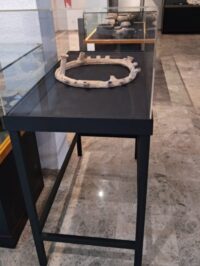 A large circular ceramic oil lamp that is the only known surviving Roman chandelier has been restored and put on display in the Archaeological Museum at Elda on the Mediterranean coast of southeastern Spain. The chandelier is more than a foot and a half in diameter and originally blazed with 32 points of light fueled by olive oil. A maker’s mark on the lamp identifies it as having been manufactured in the 1st century A.D. in the workshop of Lucius Eros, a local potter who did posterity the favor of engraving his name on the molds used to make all of his ceramic lamps.
A large circular ceramic oil lamp that is the only known surviving Roman chandelier has been restored and put on display in the Archaeological Museum at Elda on the Mediterranean coast of southeastern Spain. The chandelier is more than a foot and a half in diameter and originally blazed with 32 points of light fueled by olive oil. A maker’s mark on the lamp identifies it as having been manufactured in the 1st century A.D. in the workshop of Lucius Eros, a local potter who did posterity the favor of engraving his name on the molds used to make all of his ceramic lamps.
Founded in the 5th century B.C. as a fortified hilltop settlement in the El Monastil mountain range overlooking the Vinalopó River. The Iberian oppidium prospered from farming, hunting and forestry. The area was also rich in raw materials for ceramic production, and by the 1st century B.C. there were active commercial pottery kilns at the site and a distinctive El Monastil style had emerged.
Come the Roman defeat of Carthage, the area fell under the Roman sphere of influence. The modest Iberian town flourished thanks to its advantageous position on the river and midway along the Via Augusta than ran the length of southern Spain from Narbo (Narbonne) in the Pyrenees to Gades (Cádiz) on the Atlantic. The Romanized town, dubbed Elo, thrived off trade with Roman territories in Italy, France and North Africa, and ceramic production increased. With three kilns and a large workshop, Lucius Eros was one of the more successful potters in 1st century Elo.
In 1989, Antonio M. Poveda, professor of Ancient History at the University of Alcalá de Henares and director on sabbatical from the Elda Museum, discovered pieces of Roman pottery from the 1st century A.D. in El Monastil, in the exact spot where Lucius had his workshop. Among the artifacts found were the remains of what had been ceramic oil lamps with multiple spikes with a hole through which the wick would have emerged. Between 2009 and 2010, more fragments of at least two of these large lamps were recovered, which also featured ducts through which oil was introduced.
According to Poveda, “this type of lighting product must have been difficult to manufacture, requiring specialized potters, such as Lucius Eros’ staff. Because of their expense, they would not have been abundant, being reserved for the illumination of large rooms in the homes of the wealthy or in institutional buildings.” The archaeologist believes that Lucius’ workshop would mainly receive orders from large nearby cities, such as Ilici (now Elche) or Lucentum (now Alicante).